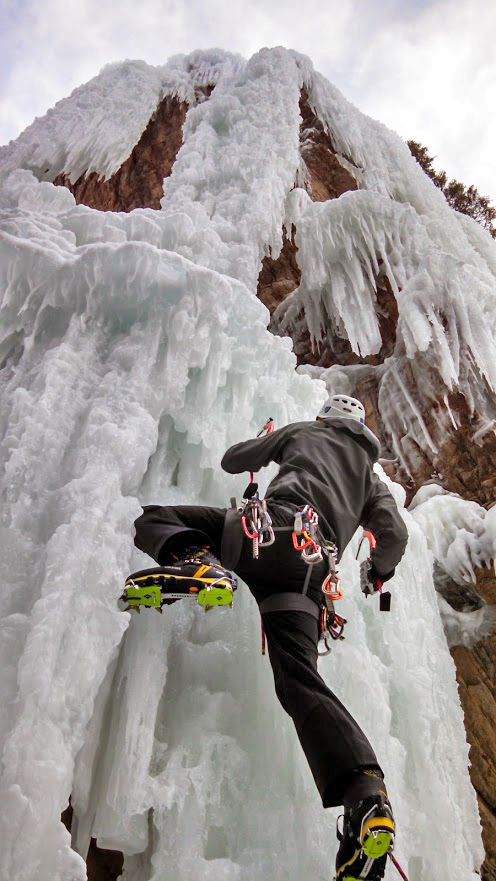
Black Diamond Stinger Crampon
MSRP: $210
Features:
- Asymmetrical design
- Replaceable mono-frontpoint
- Hooded frontpoint
- Low-profile micro-adjust heel lever
- Low-profile toe bail and thinner, shorter heel wire for improved fit with modern boots
- Front and rear dual-density ABS
- Material: stainless steel
Manufacturer’s Stated Weight: 960g per pair
Days Tested: 9
Locations Tested: Rocky Mountain National Park, Ouray Ice Park, and Vail, CO
The Stinger is a modern, asymmetric, monopoint crampon.
While Black Diamond’s Cyborg can be configured in both mono and dual frontpoint formats, it’s 13% heavier than the Stinger, and doesn’t provide the same level of precision. Dual-point crampons like the Cyborg have an edge in less technical, lower-angle affairs like gully climbing or general mountaineering, I but personally prefer using monopoints in most situations, as they sacrifice little performance in technical terrain.
This calculus is different for different users, which I’ll say more about below, but my general preference for monopoints had me especially curious about the Stinger, as it’s the most technical crampon Black Diamond makes.
The Stinger is comparable to modern crampons like the Petzl Dart, Grivel G20, and the very pricey Camp Cassin Bladerunner (which retails for $350 and is the only pair listed that I haven’t used). All of these crampons are geared toward a similar types of technical climbing (steep ice, mixed climbing, etc.) but each has a slightly different weight, asymmetry, and frontpoint geometry that may suit climbers with certain preferences more than others.
Here I’ll orient the Stinger among the other monopoint crampons I’ve mentioned with these slight differences in mind, helping you sort out whether or not the Stinger is the right call for your climbing style / preferences.
And to be clear, I am assuming that you’re interested in using the Stinger or one of these these other crampons for generally steep, technical climbing. So if you’re looking for a crampon to dedicate to steep water ice and some mixed climbing, keep reading. However, if you’re mainly interested in mountaineering, you might look for non-technical aluminum crampons. And if you want to occasionally use your crampons on steeper ice, you’ll be better off with a dual-point or modular system like the Petzl Lynx or Black Diamond Cyborg.

Asymmetrical Design
The Stinger has a very modern asymmetry which falls somewhere between that of the Grivel G20 (which is more symmetrical in shape) and the Camp Bladerunner (which is less symmetrical). This asymmetry turns the Stinger’s frontpoint inward, making it easier to kick in steps on either side and, I think, makes climbing feel more intuitive.

If you’re unfamiliar with this sort of modern crampon design, the essence of the asymmetry is this: imagine you’re looking for good purchase on the rounded curve of a pillar, and you either want to set your foot off to one side for stability, or you need to begin moving laterally. Kicking off to the side or around a curved pillar with crampons with perfectly straight frontpoints will send the points into the ice at an angle. This can make your stance less secure or simply make it harder to get good purchase to begin with. Turning the crampons’ frontpoints in helps alleviate this angle for better purchase, and makes lateral moves feel more intuitive (especially if, like myself, your climbing career began on rock and you’re used to that style of footwork).
Whether you’ll prefer more or less asymmetry across the length of the crampon will depend on personal preference as well as what sort of climbing you do; more technical ice and mixed climbing demands a different style of movement than alpine ice or moderate water ice, after all.
Stiffness
In terms of stiffness, I found the Stingers to be relatively soft—softer than the Grivel Rambo 4 and G20, and about as stiff as the Petzl Dart. Depending on the boot you climb in, this may or may not be something you notice. Super stiff boots like Sportiva Baturas or the Salewa Pro Gaiter (which I am currently climbing in) make it hard to discern subtle differences in stiffness between crampons. However, if you climb in softer boots like the Scarpa Phantom Guide, the stiffness of the crampon will do more to affect your climbing experience.
Generally speaking, stiffness is more or less preferable depending on the sort of climbing you do, in addition to the boots you’re using. Many climbers who are into sustained vertical ice enjoy the fact that stiffer plates help ease the strain on their calves over the course of a long pitch, whereas slightly softer crampons are often the weapon of choice for all-around winter climbers looking for a single set of spikes.
NEXT: Performance Pros & Cons
